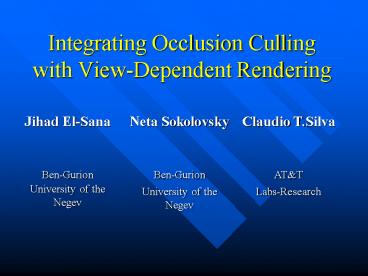Integrating Occlusion Culling with ViewDependent Rendering - PowerPoint PPT Presentation
1 / 33
Title:
Integrating Occlusion Culling with ViewDependent Rendering
Description:
Occlusion Culling Algorithms. Lists of potentially visible geometry: Airey ... Occlusion Culling Algorithms. Integration. Implementation. Results. Conclusions ... – PowerPoint PPT presentation
Number of Views:54
Avg rating:3.0/5.0
Title: Integrating Occlusion Culling with ViewDependent Rendering
1
Integrating Occlusion Culling with View-Dependent
Rendering
2
Outline
- Motivation
- View-Dependent Rendering
- Occlusion Culling Algorithms
- Integration
- Implementation
- Results
- Conclusions
3
Outline
- Motivation
- View-Dependent Rendering
- Occlusion Culling Algorithms
- Integration
- Implementation
- Results
- Conclusions
4
Motivation
- Goal
- Realism requires detailed representation
- Interactive rendering of three-dimensional
- Problem
- Visualization of large dataset
- Computation power
- Memory capacity
5
Previous work
- Multi-Resolution Rendering
- Merge trees Xia, El-Sana and Varshney
- Progressive meshes, view-dependent rendering
Hoppe - Vertex hierarchy Luebke and Erikson
- Multi-triangulation De Floriani
- View-dependent trees El-Sana and Varshney
- Illumination light dependent refinement Klein
and Schilling - Progressive transmission Gueziec et al
6
Previous Work
- Occlusion Culling Algorithms
- Lists of potentially visible geometry Airey
- Volumetric representation Sillion
- Prioritized-layered projection Klosowski and
Silva - Z-buffer visibility Green et al
- Occlusion maps Zhang et al
- Viewspace partitioning Cohen-Or et al
- Hardly Visible Sets Andujar et al
7
Outline
- Motivation
- View-Dependent Rendering
- Occlusion Culling Algorithms
- Integration
- Implementation
- Results
- Conclusions
8
View-Dependent Rendering
- The Idea
- A technique that allows several levels of details
to co-exist across different regions of the same
object - Requirements
- Appropriate levels of detail selection
- Levels of detail should merge seamlessly
9
View-Dependence Trees
- Construction
- Encode various level of detail representations
- Based in vertex-pair collapse operation.
- Bottom-up construction
- The collapsed pairs are selected based on a
simplification metric - User implicit-dependencies to prevent foldovers
Split
Merge
10
Level-of-Detail Selection
- View parameters
- Illumination parameters
- Back-facing culling
- Emphasize Silhouette
- Screen-space projection
11
Levels of Detail
- The various level of detail are represented by
breadth cut - Determination active nodes and triangles
- Regions close to the roots corresponding to low
resolution - Regions close to the bottom corresponds to high
resolution
12
Outline
- Motivation
- View-Dependent Rendering
- Occlusion Culling Algorithms
- Integration
- Implementation
- Results
- Conclusions
13
Occlusion Culling
- Often large fraction of the model polygons do
- not contribute to the final image.
- Determine hidden polygons
- Render an estimation of visible set
- Work on a budget
e
d
b
c
a
14
Prioritized-Layered Projection
- Preprocessing
- Tessellation of space
- Finding list of primitives for each cell
- Computing cells solidity
- Rendering
- Projecting front cells
- Computing solidities for neighbors
15
Outline
- Motivation
- View-Dependent Rendering
- Occlusion Culling Algorithms
- Integration
- Implementation
- Results
- Conclusions
16
Motivation
- View-dependent rendering reduces resolution based
on view-parameters. - Occlusion Culling removes hidden polygons
- Still
- View-Dependent Rendering renders occluded
triangles - Occlusion Culling renders small triangles
17
Our approach
- The combination of view-dependent rendering
with occlusion culling
18
Outline
- Motivation
- View-Dependent Rendering
- Occlusion Culling Algorithms
- Integration
- Implementation
- Results
- Conclusions
19
Preprocessing
- Impose 3D grid over a dataset
- Determine the set of polygons in each cell
- Assign a solidity value for each cell 0.0 1.0
Based on two approaches - Face projection
- Ray shooting
20
Face Projection
- Projection polygons on faces of the cell
- Ratio between projection areas and total area of
faces
21
Ray Shooting
- Shoot rays into a cell
- Determine which ray manage to leave the cell
- Ratio between passed rays and total number of rays
22
Run-Time Processing
- View-dependent rendering reduces the resolution
of far-from-viewer regions. - Hidden and close polygons are still in high
resolution. - Occlusion probability helps to recognize
invisible regions. - Reduce the selected resolution for regions with
respect to their occlusion probability.
23
Occlusion Probability
- Occlusion probability (OP)
- depends on solidity of cells.
- From viewpoint to a vertex
- Initialized OP to 0.0
- Accumulate the visited-cells solidity
- Stop when OP reaches 1.0
24
Spheres
- Four spheres Solidity values
Occlusion - dataset by point
size probability - by color
25
Adaptive Level-of-Detail
- View-dependent rendering
- Occlusion probability
- Adding the visibility as parameter in selecting
level-of-detail - LODfinal (1 - OP) LODview OP LODlowest
- OP occlusion probability
26
Outline
- Motivation
- View-Dependent Rendering
- Occlusion Culling Algorithms
- Integration
- Implementation
- Results
- Conclusions
27
Results
- 650K triangles
- 74K triangles
28
Results
- 140K triangles 86K triangles 24K
triangles - Full resolution View-dependent
View-dependent - model rendering
- occlusion culling
29
Results
- 366K triangles 296K triangles 162K
triangles - Full resolution View-dependent
View-dependent - model rendering
- occlusion culling
30
Results
31
Outline
- Motivation
- View-Dependent Rendering
- Occlusion Culling Algorithms
- Integration
- Implementation
- Results
- Conclusions
32
Conclusion
- Integration view-dependent rendering with
occlusion culling - Reduce the number of rendered triangles
- Based on estimated occlusion probability
- Selection of appropriate level
- view-parameters
- occlusion probability
33
Acknowledgements
- The Stanford Computer Graphics Laboratory
- Reviewers
Thank You































